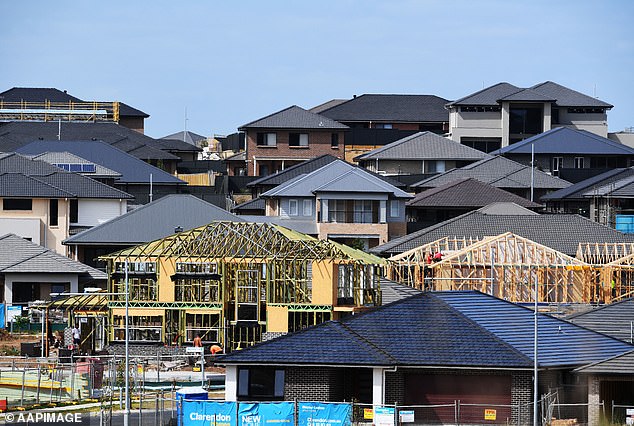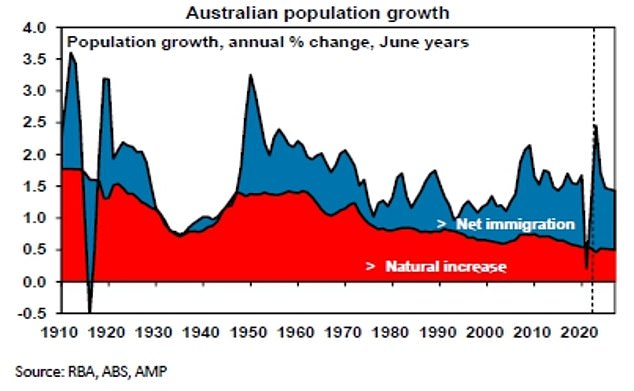Why Anthony Albanese needs to halve Australia’s immigration intake to solve the housing affordability crisis
Prime Minister Anthony Albanese is being urged to urgently halve immigration inflows into Australia to tackle the housing affordability crisis.
A record 454,400 net foreigners moved to Australia in the year to March, as skilled migrants and international students poured in.
Shane Oliver, AMP’s chief economist, expects this annual figure to rise further to 500,000 when official population data for the June quarter is released.
He argued that permanent and long-term overseas inflows needed to be reduced to 200,000 so that the supply of new housing could be maintained as the rate of population growth approached levels not seen since the 1950s.
“There has been a lot of discussion about poor housing affordability in Australia for years, but the debate about how immigration contributes to this problem is often missing,” he said.
Prime Minister Anthony Albanese is being urged to halve immigration inflows into Australia to tackle the housing affordability crisis (pictured is Sydney Wynyard train station)
The average house price in Sydney is now so expensive at $1.36 million that someone with a 20 percent mortgage deposit would still need to earn $181,000 a year to avoid mortgage stress, while a loan would cost the bank at least six times his salary is due.
That means an Australian would have to be in the top four percent of income earners just to afford a regular house in Australia’s most overcrowded city, and be paid almost double the average full-time salary of $95,581.
The situation is also bad for tenants. Data from SQM Research shows the average house rent in Sydney is $978 per week, following an annual increase of 15.6 per cent.
Dr. Oliver calculated that Australia could have a housing shortage of 285,000 by mid-2024 as rising immigration outpaces the completion of new houses and apartments.
“It is impossible to avoid the conclusion that immigration levels must be matched to the ability of the housing sector to deliver housing,” he said.
‘This is crucial. Current levels of immigration far exceed the capacity of the housing sector to deliver sufficient housing, exacerbating an acute housing shortage and poor housing affordability.”
Dr. Oliver pointed out that government efforts to build more homes – including the $10 billion Housing Australia Future Fund – were difficult to achieve given the increase in construction costs.
“The increase in immigration is exacerbating an already large supply gap and threatens to undermine governments’ additional supply commitments,” he said.
State governments are often left footing the bill for a rising population, with NSW Premier Chris Minns stating that planning rules should allow more apartments in Sydney’s established suburbs to accommodate the rising number of people.
“It means more urban development, it means more apartments and units,” he told the ABC’s 7.30pm program on Tuesday.
‘My job is to create the infrastructure and remove the red tape that blocks this type of housing supply for the state.
“If we can get that done, and at least get to the east coast first, we can alleviate some of the housing issues that young people in New South Wales in particular face.”
Despite Sydney hosting the vast majority of new migrations, Minns said he supported higher immigration – a position at odds with former NSW Labor Prime Minister Bob Carr, who had advocated lower immigration in the 1990s.

AMP chief economist Shane Oliver says net overseas immigration needs to be halved to 200,000, down from levels of almost 500,000 now, so housing supply can keep pace with population growth
“We support the Commonwealth Government’s decision to lift immigration into New South Wales, despite the fact that we will receive not the majority but the largest number of incoming immigrants,” he said.
“A lot of the labor coming into the state will be sent to the housing market and we need them to build houses and apartments.”
Dr. Oliver argued that Australia could have built 200,000 new homes annually in the five years to 2022 and that an annual net foreign migration inflow of 200,000 was needed to closely match housing supply.
Although lower than current levels, this type of annual net inflow from overseas would be comparable to a decade ago, when 206,000 migrants moved to Australia, including permanent departures abroad.
It would also be double the level of the late 1990s, before annual levels consistently reached six figures.
Australia’s population grew by 2.2 per cent in the year to March, but Dr Oliver expects this to rise to 2.5 per cent, which would be the fastest growth since the post-war 1950s.

Dr. Oliver calculated that Australia could have a shortage of 285,000 homes by mid-2024 as rising immigration outpaces the completion of new houses and apartments (pictured is construction at Oran Park in Sydney’s far south west)
Australia is now home to 2.1 million temporary visa holders and employers are concerned about possible new rules allowing sponsored skilled migrants to change jobs more easily, which could see an influx from regional areas to already overcrowded capitals, with a greater share foreign-born residents .
Shadow Immigration Minister Dan Tehan, who represents an electorate in western Victoria, said regional areas would be left without nurses, aged care staff, teachers, mechanics and chefs as possible visa changes would lead to even more overcrowding in major cities to lead.
“More migrants will move to Australia’s capital cities, further exacerbating the housing shortage and rental crisis,” he said.
“Labor’s changes will see Australians in regional communities lose access to key services, while people living in capital cities will face higher rents, worse traffic congestion and greater demand for government services such as hospitals and schools.”

Australia’s population grew by 2.2 percent in the year to March, but Dr. Oliver expects this to rise to 2.5 percent, which would be the fastest growth since the post-war 1950s.
